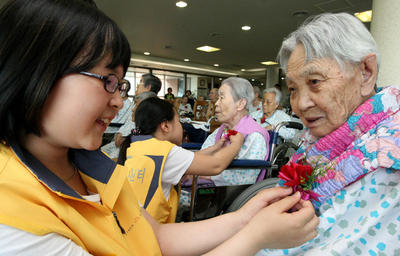In 1988, the South Korean government instituted a pension system, but payments under this system have never been adequate. According to the 2012 OECD Economic Survey, public spending for old-age benefits was only 1.6 per cent of GDP in 2007. And according to the Ministry of Budgeting and Finance, only 0.26 per cent of the 2014 national budget is allocated for services and income for the elderly. Given the actuarial basis of the 1988 National Pension Scheme, the elderly receive very small sums — a maximum of US$83 per month from the pension fund — and the full pension age of 60 is gradually being increased to 65. The limited scale of pensions plus a very restrictive public assistance program (which reaches only 3 per cent of the population and constitutes in 2014 only 0.9 per cent of GDP) leave many elderly in dire circumstances.
President Park Geun-hye in her 2012 election campaign promised to address the problem of very limited commitment to the income needs of the elderly. She pledged to provide a US$200 per month increase across the board for pensions. But she limited this increase to the poorest 70 per cent of seniors. And even with this small increase, many elderly cannot cover expenses for medications and other basic necessities.
South Korea passed the National Health Insurance Act in 1999, coming into force in 2000. Yet its impact has been limited by high co-payments under National Health Insurance for the directly insured and dependents (including elderly parents) . National Health Insurance provides benefits for medical treatment, surgery, hospitalisation and medicine, with care provided by doctors, clinics, hospitals and pharmacists under contract with the government. The insured pay 20 per cent of hospitalisations and 20 to 60 per cent of out-patient care depending on the type of facility. The maximum paid for each patient is about US$1818 to US$3636 depending on income. All citizens are covered by this program except for very low income persons who are covered by a public assistance ‘Medicaid’ program.
According to the 2012 OECD Economic Survey, high out-of-pocket payments are inequitable —‘boosting poverty and reducing necessary health care’. Even with recent limits on co-payments, these out-of-pocket expenses can still be as high as one-third of a patient’s income — and this situation disproportionately affects the elderly.
So the South Korean government has instituted the Long-Term Care Insurance Program paid for by social insurance contributions. Under the program, the local and central government each pay 20 per cent of long-term care services cost, and there is a 20 per cent coinsurance amount paid for by the client. These long-term care services include home-based services, such as a limited number of hours of home-help services, some home-visit bathing services, home-visit nursing, short-stay services, the renting of appliances as well as institutional services in a long-term care welfare or health facility.
But many of the elderly cannot afford the 20 per cent payment. And in practice the national government’s financial contribution budgeted for this program is quite limited.
Another issue is that 42.6 per cent of female unpaid labour working in family businesses are not covered by social insurance programs and are not eligible for long-term care services.
The major problem has been the reluctance of the South Korean government to support the social sector generally — particularly the poor and vulnerable elderly. National government support in fiscal year 2014 for care in a facility for the elderly constituted 0.01 per cent of GDP; support for elderly welfare assistance constituted 2.10 per cent of GDP; and national government support for long-term care services for the elderly constituted only 0.24 per cent of GDP — a clearly inadequate investment.
According to the Korean Ministry of Public Health and Welfare for 2013, absolute poverty for the elderly is having an income that is lower than the estimated minimum cost of living, which for 2013 was US$520.15/month for an individual and US$885.66/month for a two-person household. As indicated above nearly half of the South Korean elderly are living with incomes below this standard — a matter which needs to be addressed.
Given the dire position of many of the elderly in South Korea, some basic reforms could ameliorate the situation faced by the vulnerable elderly. A modest universal payment to elderly households guaranteeing a minimum income at the above levels, including a cost-of-living adjustment for future years, would ameliorate the income vulnerability of many of the elderly.
Also, much stricter limits on maximum payments for individuals under the National Health Insurance — including the cost of prescription medications, and for the Long-Term Care Insurance Program — would facilitate the elderly’s use of these programs.
Finally, rigid governmental provisions which limit the availability of social programs for vulnerable elderly parents should be eliminated.
Jongmin Shon is Assistant Professor in the School of Public Affairs and Administration at the Center for Urban and Public Services, Rutgers University.
Howard A. Palley is Professor Emeritus and Distinguished Fellow in the Institute for Human Services Policy at the School of Social Work, University of Maryland.

